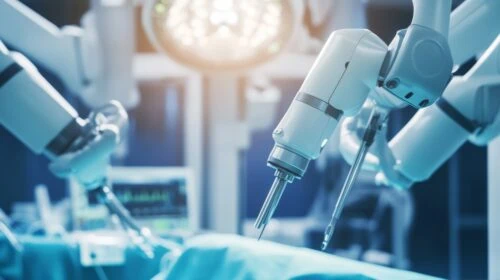 Today’s surgical robots consist of complex systems with many types of components that require exact designs and manufacturing. Among the most essential but frequently overlooked components are springs, which facilitate overall functionality and effective motion control.
Today’s surgical robots consist of complex systems with many types of components that require exact designs and manufacturing. Among the most essential but frequently overlooked components are springs, which facilitate overall functionality and effective motion control.
Whether for surgical or space exploration robots, precision-engineered springs play a key role in maximizing performance and dependability. Springs are particularly important in surgical robots to maintain consistent motion control and efficient force management. Any issues with springs, including loss of cable tension, insufficient counterbalancing, or backlash, could lead to patient injury.
Use the following guide to determine how to select the right springs for surgical robots based on their benefits and real-world applications.
Roles of Springs in Surgical Robots
Springs play a critical part in various robotics systems.
Gravity Compensation and Counterbalancing
Surgical robot springs assist with counterbalancing robotic arms. Constant force springs, in particular, enable more precise positioning. By fully or partially offsetting the force required to hold the articulating linkages, safety is improved by mitigating the risk of contact with patients.
Cable Tension and Backlash Reduction
Springs help maintain consistent cable tension and reduce backlash and slack. For instance, spring-loaded idlers and gear systems maintain cable tautness while preventing mechanical play.
Force Control and Compliance
Depending on the spring’s deflection and force, it can be used as a precision- and safety-enhancing sensor when the robot interacts with human tissue. For example, many systems use cable-attached springs and series elastic actuators (SEAs) to provide fine control and feedback.
Energy Storage in Instruments
Springs can store energy for fast, precise actions, such as surgical staplers using a twin-spring mechanism to deploy staples. Springs maintain repeatability and reliability when applying force, keeping procedures consistent.
Safety and Default Positioning
Springs also feature an automatic reset function to return surgical robots to safe positions when not active, e.g., when controller springs automatically open graspers. Buffer springs specifically provide joint limit shock absorption to prevent damage from sudden stops.
Flexible Robot Structures
Snake-like continuum robots rely on helical coil springs to keep them flexible and successfully navigate through certain anatomical pathways.
Common Types of Springs Used in Surgical Robots
Choose from different types of springs for surgical robots, including:
- Wire forms: These are custom-shaped wire elements that offer controlled tension and precision alignment for use in compact tools, such as retractors and staplers.
- Stampings: Stamped springs are found in compact assemblies for controlled force delivery in articulation assistance or jaw manipulation, such as for forceps and laparoscopic tools.
- Power springs: Coiled flat strip springs offer rotational energy in actuation and cable retraction, delivering consistent torque.
- Constant force springs: These flat, coiled springs optimize lifting force in extending robots, helping to achieve balanced surgical robot arms and efficient positioning support.
- Spiral torsion springs: These coiled ribbon springs provide consistent torque for compact robotic joints to improve rotational balancing and articulation.
- Torsion and helical springs: Many instrument grippers, wrists, and staple-firing systems use these conventional wire-based springs for their energy storage and release, durability during sterilization, and shock absorption.
- Spring reels and cable tensioners: These components help manage tubing and cables for robot arms, keeping tension consistent while preventing interference. Spring-loaded idler pulleys are often used to hold belts and cables taut throughout movement.
- Flexural springs: Bellows and helical coils, among other flexible components, provide the backbone for continuum robots, allowing their navigation of anatomical paths with optimized control and even stress distribution.
Real World Examples of Springs in Surgical Robots
Here are some real-world applications of surgical robots using spring components.
Arm Counterbalancing
Constant-force type springs help counterbalance robotic surgical arms for increased control and improved positioning without stressing the motor. Counterbalancing also prevents arms from falling on and injuring patients.
Cable Tension and Backlash Reduction
Springs help cable-driven robotic joints minimize slack and maintain tension, preventing backlash that might result in inaccurate procedures.
Force Control
Robotic instruments frequently use springs as compliant elements to boost safety when interacting with tissue. They may also act as force sensors that measure deflection for feedback control.
Energy Storage in Surgical Tools
Staplers and other surgical instruments use springs for energy storage and release, often through twin-spring mechanisms in staplers with consistent force.
Safety and Automatic Reset
The automatic reset function of springs puts them in safe positions when not in use, and they can function as buffer elements for shock absorption.
Flexible Structural Backbones
Many continuum robots rely on springs to help them maneuver in a snake-like motion with consistent accuracy and precision.
Precision Engineered Springs From John Evans’ Sons
While springs are small components, they are integral to functional surgical instruments and robotics. The right spring designs can increase precision, accuracy, and safety to ensure better patient outcomes. They can optimize energy storage, motion control, and force control to effectively function as the extension of the human hand while reducing the risk of human error.
Medical device engineers must take springs into consideration early in the design process, choosing the most appropriate materials based on their needs. At John Evans’ Sons, we have over 175 years of experience developing high-quality springs of all types.
Contact us today for more information about our offerings, or request a quote for a custom spring solution that meets your needs.
Contact Us Today!
"*" indicates required fields